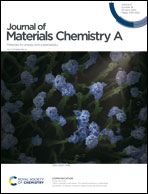A highly active Ni/Ce0.8Sm0.2O1.9 anode catalyst with a three-dimensionally ordered macroporous structure for solid oxide fuel cells
Abstract
Ni/Ce0.8Sm0.2O1.9 (SDC) with a three-dimensionally ordered macroporous (3DOM) structure is prepared with poly(methyl methacrylate) as the template and characterized using X-ray powder diffraction, scanning electron microscopy, transmission electron microscopy, H2 temperature-programmed reduction, X-ray photoelectron spectroscopy and ultraviolet Raman spectroscopy. Lattice oxygen in 3DOM SDC shows a higher activity than that in hydrothermally synthesized bulk SDC. 3DOM SDC also exhibits a stronger interaction with Ni compared to bulk SDC, which facilitates the release of lattice oxygen and the formation of oxygen vacancies in SDC in a reducing atmosphere. Therefore, Ni/3DOM SDC shows a much higher catalytic activity for electrochemical oxidation than Ni/bulk SDC as the anode material of solid oxide fuel cells. With Ni/3DOM SDC as the anode, a cell supported by a 500 μm-thick SDC-carbonate composite electrolyte layer exhibits maximum power densities (Pmax) of 1.28 and 1.63 W cm−2 at 700 °C with H2 and methanol as fuels, respectively, more than twice the Pmax of a similar cell with a Ni/bulk SDC anode. The Ni/3DOM SDC anode also shows a high resistance to coking.



 Please wait while we load your content...
Please wait while we load your content...